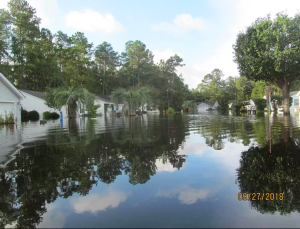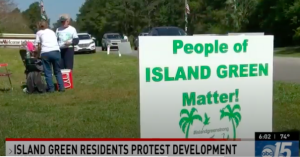
Saving Island Green Wildlife & Beyond is located next to the Waccamaw Wildlife Refuge in the Island Green community in Horry County, SC. This fragile slice of paradise, built before zoning and development codes, has wetlands like the adjacent refuge. With a little more than 1/3 of the community considered to be in a flood plain and FEMA’s flood zone map, the environmentally-sensitive area is prone to flooding. The organization faces four main issues: the safety of residents, the lack of road infrastructure to accommodate additional homes, the probability of increased flooding, and the destruction of wildlife and their natural habitats. In April of 2021, Saving Island Green residents led a protest at the entrance of their community against developers and Horry County elected leaders. The group continues to seek substantive discussion of alternative options with the developers, including interest from a land trust.

Photo of flooding in Island Green in 2018 taken by resident Cheri.
Dawne Dunton founded Saving Island Green (SIG) in 2019 after seeing surveyors harassing an alligator in a pond behind her home and learning that development – particularly using dangerous fill-and-build practices – was going to replace the area’s fragile beauty. Alarmed by overdevelopment, safety concerns, and flood risks in Island Green, the grassroots group took action. Armed with a camera, Dunton documented everything, from a forgotten tram line, now registered with the South Carolina Institute of Archeology and Anthropology, to the natural beauty of Peach Creek and rare breeding Limpkins. Partnering with scientists of the Thriving Earth Exchange, they assessed development’s impact on flooding and wildlife. SIG petitions to conserve land and uses public records to hold developers accountable. Dunton’s book “What I See in Island Green” and SIG’s documentary “Island Green is Alive” raise awareness for both the beauty and the fight to save it.

The television coverage of the protest that Island Green residents, including Dawne, had at the entrance of their community.